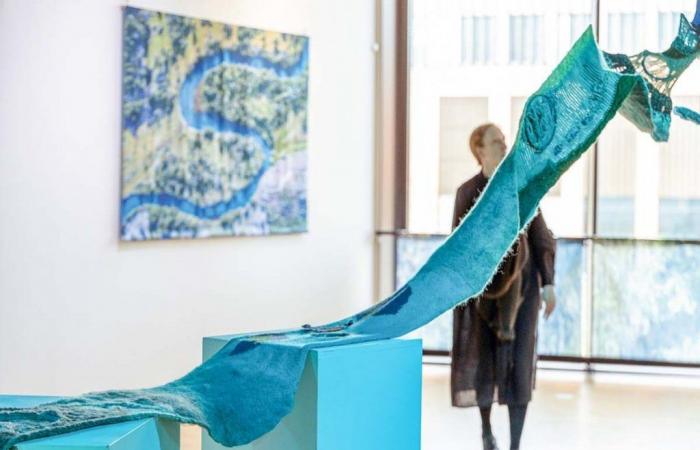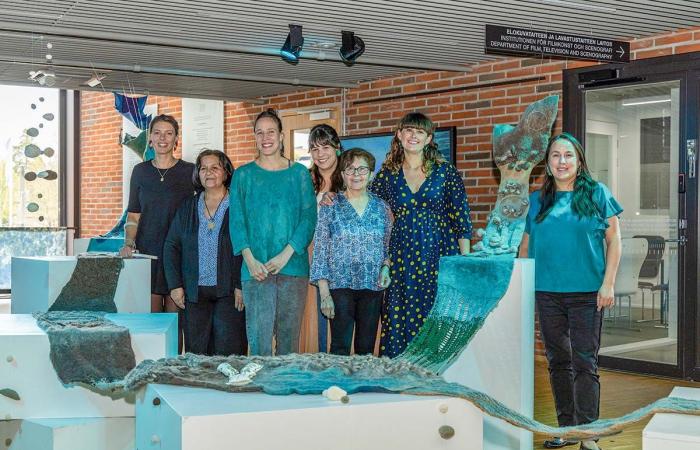Different textile languages, between toothpicks, crochet, embroidery and felt, gave life to an 11-meter-long rivera textile representation of the river that crosses the community of Cochrane, in the Aysén region.
The work entitled A woven river It is part of an interdisciplinary investigation into the community’s links with the river they inhabit, carried out by Pulso Austral, an organization of women working from different disciplines in the Aysén region.
“Our south, as we always say, is working for the well-being of communities through initiatives that combine topics linked to art, education, culture and science,” explains historian and journalist Catalina Camus, part of Pulso Austral.
The organization has always worked through textiles, a language that crosses different projects, such as the Textile Atlas podcast, where they talk with artisans, and the training program for groups of artisans called the Creative Laboratory of Textile Trades.
They are also working with artisans in rural schools to create community tapestries. “This is where intergenerational links between children and older adults intersect, and we create these tapestries based on sewing and embroidery, which speak of local identity, of the connection with nature, of knowledge linked to cultural heritage,” explains Catalina Camus.
It was through this work that the idea for the Woven River Art and Science Project was born. Catalina Camus, who researches textile crafts, the psychologist Cecilia Moura and the textile designer Francisca Vidal participated in it.also part of Pulso Austral.
In addition to the biologist Anna Astorga, who has been working in the region for years in the different water basins, and two artisans from Cochranewho had already participated in the Creative Laboratories program.
“They are two weavers who are also relevant community actors, very loved. So we brought this great team together and decided to give life to a project that allows us to link two themes that are super powerful in the area: the textile trades and the link with the river,” says Camus.
Through interdisciplinary research and active community participation, in which the Patagonian Ecosystem Research Center (CIEP) also participated, the objective was to give life to a textile work that represented the biological characteristics of the Cochrane River and the links what the community has with the river.
“We wanted to see how this community is linked and how we can interpret this research in a close, coherent, artistic and creative way, and that is how the idea of weaving this Cochrane River was born, interpreting the links and also interpreting the scientific data collected by the ecologist who participated,” says Catalina.
From Aysén to Helsinki
After its premiere in Cochrane, south of Aysén, The work landed at the first Textile Art Biennial in Chile last year, and in May of this year it traveled to Aalto University in Helsinki.At the Faculty of Arts, Design and Architecture, they presented the collective work that crosses the boundaries between art and science, where you can see everything from a caiquén and a puye, to a diplodon and other species embroidered and illustrated on fabric.
The launch in Finland ended with a discussion on creative practices for participatory researchwhere in addition to the knitted river and its findings, the project From the lab and the studio to the garden, the forest and back was presented, which seeks to reveal new places of knowledge in daily life outside of laboratories and studios, led by the prominent designer Dr. Andrea Botero, who was the host of the Chilean delegation.
“I have found the work of the Pulso Austral team incredible since they were introduced to me and I knew that their experience would resonate with people here in Finland, who are also looking to connect with ways of building community and thinking about the future together. What they achieve together with the community and other researchers is very powerful in understanding the alliances and creativity that we need to mobilize in these challenging times,” said Aalto University academic Dr. Andrea Botero.
For spinner, dyer and weaver Violeta Flores, part of the team, participating in this trip was an unforgettable experience. “I felt very fulfilled. I really liked what it had in the people who went to see the river, they were very enthusiastic to know more about our project. I felt that the collective work that was done together was valued, they valued the very fabric of the river and the way in which it was carried out. It was very nice to be able to feel that,” she declared.
For now, Pulso Austral seeks to continue with the project, even reaching other basins in the region.. “We also want to work on interdisciplinary research, uniting more disciplines, institutions and making this project grow, the idea being to allow us to reflect on how we are linked to the river that passes through our city. What colors it has, how it changes in the seasons of the year, where it is born, where it goes, how it changes along its journey and how we affect it as human beings, as a community. So we can address all these questions in this new project that we want to bring to life in the commune of Coyhaique in the future, for the next two years,” Camus advances.



